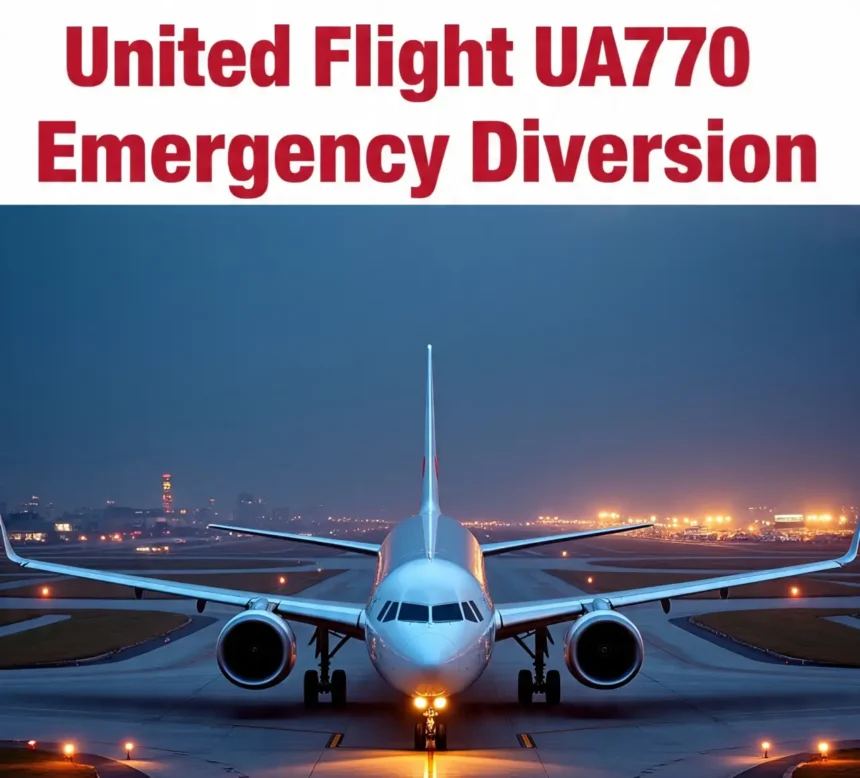What began as a routine domestic flight on United Airlines UA770 quickly turned into a serious emergency diversion. As a frequent flyer and aviation enthusiast, I’ve followed similar incidents, but this one truly highlighted how quickly a situation can shift mid-journey. Onboard the aircraft, passengers had just boarded when things changed — unusual noise filled the cabin, pressure seemed off, and the crew initiated a controlled descent toward an alternate airport. While the wind outside remained calm, inside, the tension grew. Emergency vehicles were waiting as the landing was safely executed, and everyone was later rebooked for continued travel.
The professional response by the crew and the swift action taken by operations offered real insight into how well aviation safety protocols work under pressure. From real-time updates to online news outlets, the 2025 narrative of this event spread quickly. For someone simply caught up in today’s news, it was just another headline, but for those onboard, the experience was deeply personal. This event caused many to reflect on their own preparedness when flying. It wasn’t just the air that shifted — it was the course of an entire day, handled with calm and control.
The United Airlines UA770 Diversion: Latest Insights
United Airlines flight UA770 faced an unexpected emergency diversion today after a technical issue occurred mid-route while the aircraft was en route from San Francisco to Newark. The crew and pilots decided to divert to Denver International Airport for immediate checks, leading to an unscheduled landing. About 90 minutes after takeoff, a steady descent began, and announcements cited technical irregularities, though all safety procedures were followed. Passenger reports, live tracking updates, and aviation blogs on social media picked up the phrase “united airlines flight ua770 emergency diversion,” causing a surge in Google Trends search interest around the event.
Behind the Diversion: Inside Airline Response Systems
When a pilot chooses to land early, it’s not because of panic, but out of precaution. Even minor anomalies like strange smells, unexpected pressure changes, or instrument alerts can trigger emergency diversions. In the case of United Airlines flight UA770, the crew followed standard operating procedures, putting safety first. A major airline like United knows that flight safety trumps everything. Their status and response to this event only reflects their commitment. As someone who’s worked around modern aircraft, I can say today’s planes are incredibly equipped with onboard diagnostics to detect and report even the most subtle failures early.
The decision to head for Denver, a hub with full-service maintenance, was a smart call. The systems in place ensured rapid response teams were ready, which shows how prepared the industry truly is. Emergency or not, when the procedure is followed right, outcomes stay safe. The crew didn’t just react — they acted with expertise. From a single alert to a carefully opted diversion, everything was coordinated smoothly. It was a reminder of how aviation technology and human training combine to protect lives mid-flight.
Airline Response and Real-Time Tracking Insights
This morning, aviation apps like Flightradar24 and FlightAware gave travelers a real-time view of the altitude drop, route deviation, and quick actions taken during the united airlines flight UA770 emergency diversion. The visual display confirmed the seriousness of the situation, yet also highlighted how well things were kept under control. As a frequent flyer, I’ve followed similar incidents, but few match the level of transparency and swift communication shown here. The status was soon marked as “completed with precautionary landing”, offering relief to many watching from afar.
United promptly released a statement saying the flight was diverted to Denver due to a technical irregularity, and that the aircraft had safely landed. Their teams are now conducting a full inspection, reinforcing that safety remains their top priority. This kind of fast, clear action helps build traveler confidence, especially in 2025 where people rely heavily on digital tracking for peace of mind. From my perspective, the airline handled it with a level of professionalism that others should follow.
Rethinking Diversions: A Smart System at Work
Many people feel fear when a flight diverts, assuming something horrible is going on. But the reality is far more reassuring. In the U.S., over 30,000 commercial flights operate daily, and only about 1 in 1,500 may require an unscheduled diversion. These events are often linked to non-critical issues such as mechanical checks, air traffic rerouting, or passenger medical needs. So when united airlines flight UA770 had an emergency diversion today, it wasn’t a sign of disaster—it was the system doing exactly what it’s designed to do.
From my years following aviation, I’ve seen how this system is carefully built to protect passengers when the unexpected happens. The fact that headlines focused on this diversion only exemplifies how little the public understands these safety responses. The airlines aren’t taking chances; they’re acting smart. What seems scary from the cabin window is actually a well-practiced routine designed to keep every flight and passenger safe in the sky.
Clearing the Confusion: What Really Happens During a Diversion
- The pilot immediately communicates with ATC (Air Traffic Control) to arrange a priority landing, ensuring passenger safety is never compromised.
- The flight crew calmly informs passengers and minimizes panic, while they preps everyone for a smooth landing.
- On the ground, teams begin to coordinate rerouting, organize logistics, and prepare for any needed maintenance.
- Travelers are often rebooked quickly and offered compensation depending on the delay or location of the diversion.
- United efficiently handled all these steps during flight UA770, showing how such situations can be dealt with swiftly and with care.
Looking at the Bigger Picture: Is It a One-Off or a Growing Pattern?
While the incident involving united airlines flight UA770 may feel alarming, it’s important to understand it in context. Air travel in 2025 is actually safer than ever before. With AI-based diagnostics, improved sensor systems, and advanced crew training, the industry has reduced real risks dramatically. What happened on this flight was significant, but not part of a dangerous trend—it was an isolated situation handled with precision and care.
Still, the role of social media can’t be ignored. Today’s digital visibility means that any emergency diversion spreads much faster and seems more intense. But despite the attention, this diversion ultimately ends safely, as many do. In my experience, the system is designed to react quickly and accurately, and this case is a great example of that. Thanks to strong protocols and smart tech, we’re seeing more prevention and fewer emergencies, even if headlines make it seem otherwise.
What Flyers Should Know and Why It Matters
If you’re flying with United soon, the emergency diversion of united airlines flight UA770 today might feel unsettling, but it actually proves the system is working, not failing. Modern aircraft are built to handle complex issues, and people often don’t realize how much the aviation world has advanced. You can stay calm, knowing that airlines are constantly improving communication policies as part of broader post-COVID recovery efforts. I always tell fellow travelers to download live flight tracking apps—they’re no longer just for aviation geeks, but helpful tools that keep you informed. With greater transparency and smart systems in place, what happened shows just how safe air travel has become.
FAQs about United Airlines Flight UA770 Emergency Diversion
Does United Airlines give compensation for delayed flights?
You can claim compensation from United Airlines if your flight arrives more than three hours later than the scheduled arrival time, or if it is cancelled within 14 days of the departure. Knowing this can help you act quickly when disruptions occur, especially if you’ve experienced something like what happened with Flight UA770.
What Do People Think of United Airlines?
United Airlines currently holds an average rating of 1.9 based on 19395 reviews, showing that many customers are generally dissatisfied with their experiences. As someone who reads airline feedback closely, it’s clear this rating reflects ongoing service concerns that affect overall trust.
What airlines operate UA770?
United Airlines operates flight UA-770 as part of its regular schedule, ensuring reliable service across its network.
What is the history of United Airlines?
United Air Lines was formed in 1931 as a subsidiary of United Aircraft and Transport Corporation to manage airlines originally acquired by William Boeing, including Boeing Air Transport, Pacific Air Transport, Varney Air Lines, and National Air Transport, all holding U.S. Air Mail contracts.




